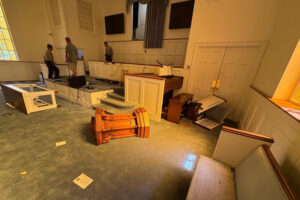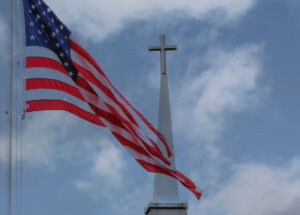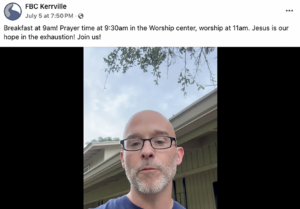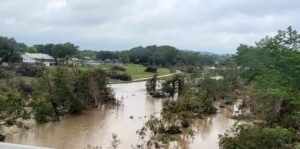
ROCKVILLE, Va. (BP)–When Tom Billings looks at Houston today, he sees a very different city than the Houston of a generation ago.
It’s bigger, to be sure. The Texas urban giant counts more than 6 million people within its metropolitan area, now the fifth-largest metro region in the United States. But it also has become a coat of many colors — and cultures and languages.
“In 1980, Houston was a biracial southern city: black and white, mostly white,” says Billings, executive director of the Union Baptist Association, which serves some 600 Southern Baptist churches in greater Houston.
Today, it is a major immigration portal and one of the most ethnically and culturally diverse urban centers in North America. One in four Houston residents was born overseas. Billings and his ministry team have identified some 350 different ethnolinguistic people groups. More than 150 languages are spoken by the families of students in the public schools.
“I remind [churches] that we are responsible for reaching all of the people in the city, not just the folks that look like us,” Billings says. “It’s hard for us to cross over those barriers and boundaries in order to reach out, but we’ve got a responsibility for other people. That’s the Great Commission.”
To reach the rainbow mosaic of peoples in today’s Houston, however, Billings says he had to learn to think like a missionary — and a global mission strategist.(Hear more of Billings’ perspective at https://media1.imbresources.org/files/129/12905/12905-73035.flv)
He’s far from the only one.
‘BEYOND ARTIFICIAL BOUNDARIES’
Billings joined 12 other leaders from Southern Baptist churches, associations, seminaries, state conventions and the North American Mission Board May 9-10 to trade ideas with eight International Mission Board strategists at the IMB’s International Learning Center in Rockville, Va. The two-day roundtable, “Engaging Unreached People Groups in U.S. Urban Centers,” focused on the opportunities and challenges of a rapidly shifting cultural landscape.
“We need to get beyond artificial boundaries and geopolitical borders, even in North America,” said Ken Winter, IMB vice president for church and partner services, who organized the dialogue. “It’s a new day in partnership and collaboration between church planters, NAMB and IMB in engaging unreached peoples in North America with shared resources, training, research and strategy.”
The session came two weeks after NAMB President Kevin Ezell met with IMB President Tom Elliff April 25 to brainstorm new ways to partner in mobilizing Southern Baptists to evangelize the lost, make disciples and plant new congregations. While the two mission boards have different ministry assignments and responsibilities, “we’re making a determined effort to forge a new and stronger relationship,” Elliff said after that meeting.
The urban face of North America is changing radically as the world rushes toward the United States and Canada. Refugees, immigrants, international students, high-powered executives with global corporations — they come from many places and for many different reasons. But they continue to come, settling primarily in cities. And they need to know about the love of Jesus.
According to current mission research, 584 unengaged, unreached people groups can be found in North America. In other words, these groups haven’t heard the Christian Gospel presented in ways they can understand it and respond to it, and no evangelical group has a viable plan to reach them. Many of them live in urban — or urbanizing — areas.
‘GLOBAL FOOTPRINT’
The New York City metro area, where NAMB missionary Steve Allen works as a church catalyst for the Metropolitan New York Baptist Association, is home to about 22 million people. They speak as many as 800 languages. Two-thirds of them are first-generation immigrants or their children.
“We’re just starting to put a face on a lot of these people groups,” Allen said during the roundtable session. (Hear more from Allen at https://media1.imbresources.org/files/129/12904/12904-73030.flv.) “But there’s never been a better time to engage New York and North American cities, because that’s where God is at work.”
Another example: Gwinnett County in Georgia, once primarily rural, now a part of sprawling urban/suburban greater Atlanta. Gwinnett’s population nearly doubled, to more than 800,000, between 2000 and 2010. The county plays host to some 1,400 technology companies, many of them global corporations with substantial numbers of international employees.
“Within a 20-minute drive of our church, we’ve got 26 mosques and Islamic centers,” said Troy Bush, minister of evangelism and missions at Cross Pointe Church in Duluth, a suburban community in Gwinnett. Only 32 percent of the children in his daughter’s school system are Anglo. The largest Hindu temple in the United States sits in Lilburn, a 15-minute drive away.
“Atlanta’s ‘global footprint’ is enormous,” Bush said. “We’re talking about the heart of the Bible Belt and the radical changes that have taken place right here. We literally have peoples from all over the world. They’re bringing in a plurality of religious views, everything from Buddhism to Hinduism to Islam and other religious beliefs. The challenge for our churches is to recognize this and then develop strategies to engage them with the Gospel, start churches and make disciples among them.”
It’s an overwhelming task, even for a passionate advocate like Bush, a former IMB missionary to the Russian megacity of Moscow. He also teaches urban ministry at Southern Baptist Theological Seminary in Louisville, Ky.
“One of the challenges is simply identifying [the different people groups] and understanding who they are,” Bush said. (Hear more from Bush at https://media1.imbresources.org/files/129/12906/12906-73040.flv.)
The roundtable participants discussed the massive research task, as well as available and needed tools and resources, obstacles to effective outreach inside and outside churches, how to build networks and partnerships — and ways IMB missionaries and strategists can “come alongside” in appropriate ways to assist.
Some of the many ideas and possible initiatives discussed:
— Share and partner in research on unreached peoples in urban centers.
— Develop a coordinated people-group information database.
— Provide practical, accessible training and resources to individuals, churches, associations and teams struggling with the often-bewildering challenges of rapidly changing urban areas.
— Connect IMB workers assigned to reach people groups overseas with churches and ministry leaders reaching out to the same peoples in North America — and vice versa.
— Increase opportunities for missionary candidates, missionaries on stateside assignment and retiring or former missionaries to work with churches and teams reaching out to unreached peoples in the United States.
— Equip and train cross-cultural church planters in North America (potential NAMB/IMB partnership).
— Encourage missionary applicants who cannot be sent overseas for various reasons to explore the option of engaging unreached peoples in North America.
‘CROSS-POLLINATION’
This kind of “cross-pollination” could multiply the effectiveness of reaching the unreached wherever they are, said IMB mobilizer Terry Sharp, who works with Southern Baptist state conventions and associations.
“We can partner with churches and associations in North American urban centers to orient and equip new missionaries preparing to go to international fields,” Sharp said. “In New York City, for example, missionaries preparing to go to India, West Africa or Russian-speaking countries could do residencies in Little India, Little West Africa or Little Odessa. NAMB missionaries working among these peoples in New York could be trained by IMB trainers, side by side with IMB missionaries preparing to deploy overseas.”
For churches or individuals who want to get involved, three opportunities are on the horizon. “EthnéCITY: Reaching the Unreached in the Urban Center,” is a gathering designed for pastors, missionaries, church planters, missions leaders, students or anyone “interested in exploring what it will take to engage the diaspora of unreached people groups in the urban centers of the world.” The gatherings will occur Oct. 20-22 in New York, Nov. 17-19 in Houston and May 3-5, 2012, in Vancouver, Canada. To find out more or register, visit https://ethnecity.com.
–30–
Erich Bridges is an International Mission Board global correspondent.















